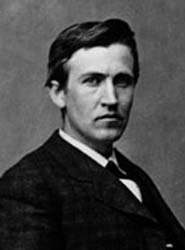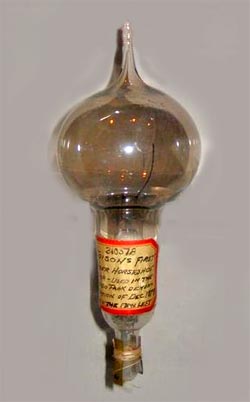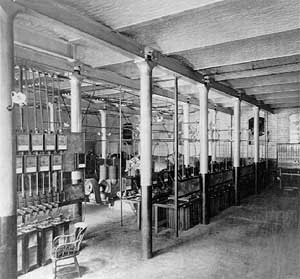|

Edison's
incandescent lamp lit the world, but did he really invent
it? (Copyright Lee Krystek, 2002.)
|
Surprising
Science:
Who
Invented the Lightbulb?
It was Thomas Edison in 1879, wasn't it? That's
what many people think and were taught in school. Like most
stories, however, there is a lot more behind the creation of
this important and ubiquitous object than just Mr. Edison..
The story of the lightbulb really starts almost
seventy years earlier. In 1806 Humphrey Davy, an Englishman,
demonstrated a powerful electric lamp to the Royal Society.
Davy's lamp produced its illumination by creating a blinding
electric spark between two charcoal rods. This device, known
as an "arc lamp," was impractical for most uses. The
light, similar to that of a welding torch, was simply too bright
to be used in residences and most businesses. The device also
needed a tremendous source of power and the batteries which
powered Davy's demonstration model were quickly drained.
As time went on, electric generators were invented
that could feed the arc lamp's need for power. It found its
way into applications where a brilliant source of light was
needed. Lighthouses and public assembly areas were obvious uses.
Later arc lamps were used in war to power huge searchlights
used to spot enemy planes. Today you can see such searchlights
lighting up the sky near movie theaters or at the opening of
a new stores.
The
Incandescant Light
Some 19th century inventors wanted to find a way
to "subdivide" the light from Davy's arc lamp so that
it could be used in the home and office. Other scientists thought
that a completely new technique for making electric light held
more promise. This method of generating light was known as "incandescence."
Scientists knew that if you took some materials
and passed enough electricity through them, they would heat
up. They also knew that if the material got hot enough, it would
start to glow. The problem with this method of making light
was that before long either the material would burst into flame
or melt into a puddle. If incandescent light was to be made
practical, these twin problems would have to be solved.
It occurred to inventors that one way to keep their
incandescent "burners" from catching fire was to not
let them come into contact with oxygen. Oxygen is a necessary
ingredient in the combustion process. Since oxygen is in the
atmosphere, the only way to keep it away from the burners was
to enclose the burner in a glass container, or "bulb,"
and pump out the air. In 1841 a British inventor named Frederick
DeMoleyns patented a bulb using just this technique in combination
with burners made of platinum and carbon. An American named
J. W. Starr also received a patent in 1845 for a bulb using
vacuum in conjunction with a carbon burner. Many others, including
an English chemist named Joseph Swan, improved and patented
versions of bulbs using a vacuum with burners of various materials
and shapes. None, however, proved practical for everyday use.
Swan's lamp, for example, used carbonized paper that would quickly
crumble after being lit a short time.
|

The
brash, young inventor Thomas Alva Edison.
|
Edison
Joins the Fray
It was obvious, though, that incandescent lighting
would be a huge financial success if it could be perfected,
so many inventors continued to work on finding a solution. It
was into this environment that the brash, young, inventor Thomas
Alva Edison entered the race to make-a-better-bulb in 1878.
Edison was already world famous for having created and commercialized
several items, including a better stock market ticker and the
phonograph. In October of that year, after working on the project
for only a few months, he declared to the newspapers "I
have just solved the problem of the subdivision of the electric
light." This rash pronouncement was enough to drive the
stocks of the gas companies (whose lamps supplied the current
form of lighting) down into the ground.
As it turned out, Edison's announcement was premature.
He had an idea of how to solve the problems of the electric
incandescent light, but had not yet perfected it. His idea was
to enclose a platinum burner in a vacuum. When other inventors
had done this the platinum melted, but Edison thought he had
solved that problem by building a temperature-sensitive switch
into the bulb that would cut off the current when the temperature
got too high. This was a great idea, but unfortunately it didn't
work. To keep the bulbs cool enough, the switches had to cut
the current off very quickly. This resulted in a constant flickering
which made the bulbs unusable (this same switching principle
is currently used in Christmas tree bulbs to make them blink
on and off).
It was soon obvious to everyone working on the incandescent
light at Edison's Menlo Park laboratory that another approach
was needed. Edison decided to hire a young physicist named
Francis Upton from Princeton University to work
on the project. Up to this point Edison's staff had been trying
idea after idea to get the bulb to work. Under Upton's guidance,
they started looking at existing patents and research to try
and avoid repeating other people's mistakes. The staff also
started doing basic research on the properties of the materials
they had been working with.
|

An
Edison builb from 1879 that was used to light his Menlo
Park laboratory. (Photo by Alkivar licensed
under the Creative Commons Attribution-Share Alike 3.0
Unported license.)
|
One of the results of testing the properties of
the materials was the realization that any burner chosen would
have to have a high electrical resistance. All materials have
an amount of electrical "friction" that resists electricity
moving through it. This is known as the material's electrical
resistance. Materials with high resistance more easily get hot
when electricity passes through them. Edison soon realized that
any good burner would have to have a high electrical resistance,
otherwise too much electricity would be needed to warm the material
to the point where it would give off light. This revelation
meant that Edison's staff need only to test high-resistance
materials to find the one they wanted.
This information also started Edison thinking about
the electric lights not only as an end to themselves, but how
they fit as part of a whole electrical system. How big would
the generator need to be to light a neighborhood? What voltage
should be delivered to a house?
By October of 1879 Edison's workers began to see
some results. On the 22nd of that month a thin, cotton "carbonized"
thread burned for some 13 hours during an experiment. Longer
times were achieved by modifying the vacuum pumps and creating
a better vacuum inside the bulb (less oxygen inside the bulb
slowed the burning process). More carbonized organic materials
were tested and Japanese bamboo proved to be the best. By the
end of 1880 Edison's carbonized bamboo burners, now called filaments
because they were fashioned into a long, thin thread, were burning
in bulbs as long as 600 hours. The "filament" proved
to be the best shape to increase the materials electrical resistance
and physical strength.
The carbonized bamboo had a high resistance and
fit well into Edison's scheme for building a whole electrical
power system to provide lighting. By 1882 he had established
the Edison Electrical Light Company which had a generating station
located on Perl Street, providing New York City with electrical
lighting. In 1883 Macy's in New York City became the first store
to install the new incandescent lamps.
Edison
Vs. Swan
Meanwhile over in England, Joseph Swan had again
gotten involved in working on the lightbulb after he saw that
new pumps made it possible to produce a better vacuum. Swan
made a lamp which worked well for demonstrations, but was impractical
in actual use. Swan's burner was made of a thick carbon rod
that gave off gases that soon covered the inside of the bulb
in soot. Also, the low resistance of the rod meant that the
bulb used up too much power. After seeing the success of a high
resistance, thin filament in Edison's lamps, Swan incorporated
this improvement into his own bulbs. After founding his own
company in England, Swan found himself sued by Edison for patent
infringement. Eventually the two inventors decided to stop fighting
and join forces. The company they formed, Edison-Swan United,
became one of the world's largest manufacturer of lightbulbs.
|

An
early Edison power generation plant.
|
So did Edison invent the lightbulb? Not really.
Others had produced an incandescent light before him. He did,
however, create the first practical lightbulb along with an
electrical system to support it, certainly a significant achievements
in their own right.
Of all the inventions Edison was involved in - the
stock ticker, the phonograph, the telegraph and the mimeograph
- only the incandescent lightbulb remains in general use today.
It is a testament to how great a job Edison and his workers
at Menlo Park did in taking this invention out of the laboratory
and putting it into the home.
A
Partial Bibliography
They
All Laughed by Ira Flatow, HarperCollins Publishers, 1992.
Lamp
Inventors 1880-1940: Carbon Filament Incandescent,
National Museum of American History, Smithsonian Institution,
C:\My Documents\unmuseum\lightbulb\Lighting A Revolution Joseph
W_ Swan.htm, 2002.

Copyright Lee Krystek
2002. All Rights Reserved.